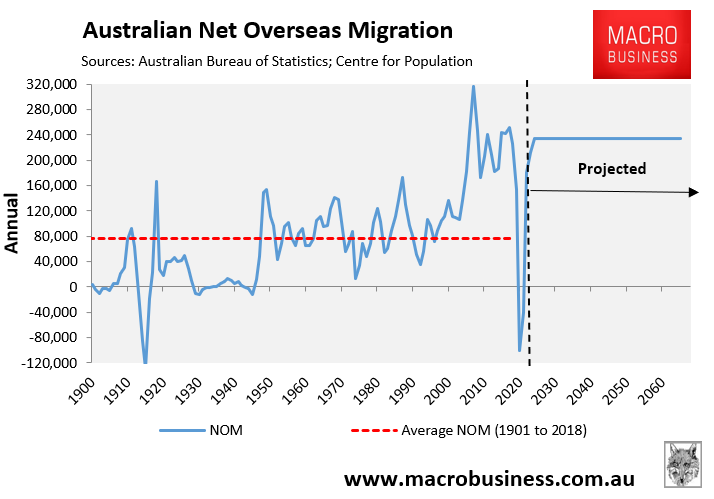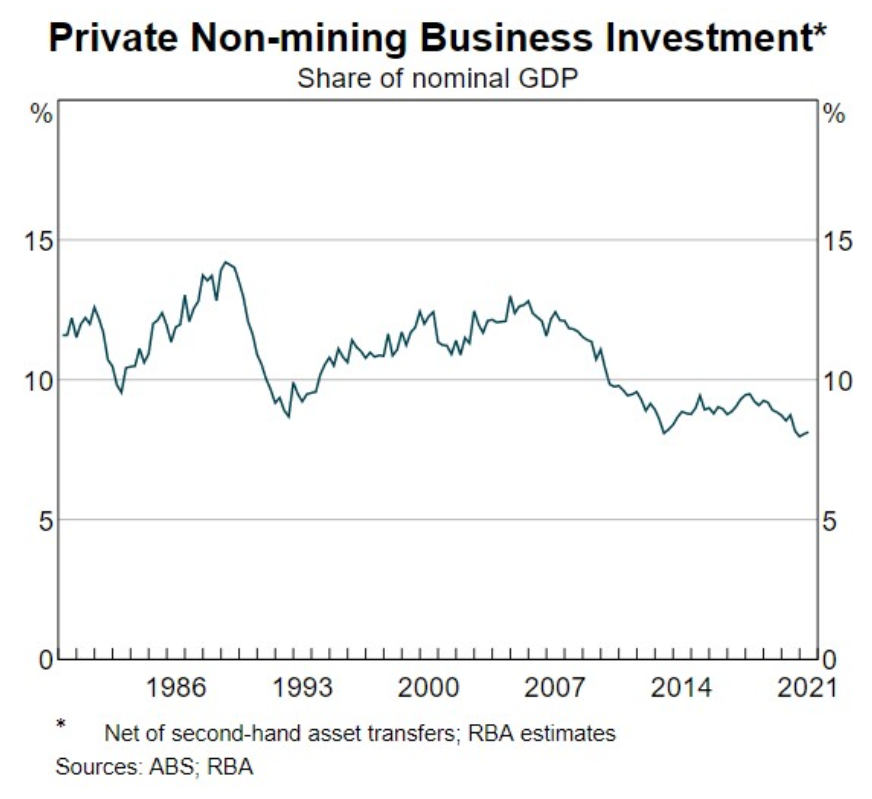Former Treasury Secretary, Dr Ken Henry, has lambasted Australia’s plummeting economic performance over the past two decades, which saw the nation’s productivity collapse:
Dr Henry said Australia’s economic performance over the last two decades was “a great disappointment” because not enough action had been taken to address challenges policymakers knew were coming”.
“We’ve been aware of the economy’s failings for quite some time,” he said. “It was 20 years ago when we published the first intergenerational report, which set out the challenges that were emerging … due principally to an ageing of the population.”
Dr Henry said that it was clear two decades ago there was a “need to find ways of growing the economy much faster”.
“We pointed in particular to productivity growth,” he said.
Dr Henry said the belief then was that, if the nation only managed productivity growth of 1.75 per cent per year, the nation “would be in a hell of a mess in 40 years time”.
“We actually achieved 1.25 per cent,” he said.
Arguably the biggest policy change that occurred over this period was that Australia dramatically ramped-up its immigration intake under the false assumption that it would lift productivity and living standards:

Australia’s net overseas migration soared after 2005.
Australia’s net overseas migration (NOM) jumped from an average of 90,500 between 1991 and 2004 to an average of 219,000 between 2005 and 2019 – representing an annual average increase in immigration of 140%.
To add insult to injury, Australia is officially projected to import 235,000 migrants a year over the next 40 years, which will see Australia’s population balloon by an absurd 13.1 million people (50%) over that time period.
If Big Australia lobbies like the Grattan Institute were correct in arguing that mass immigration improves productivity, then why did Australia’s productivity collapse after immigration was more than doubled? Something doesn’t add up.
The truth of the matter is that the dramatic lift in immigration very likely contributed to Australia’s poor productivity performance via several channels.
First, the massive rise in population growth creates chronic infrastructure bottlenecks across capital cities, driving up congestion costs.
The infrastructure investment required to keep pace with population growth is much more expensive than in the past, due to diseconomies of scale (e.g. tunnelling and land buy-backs). This means that every additional unit of infrastructure increases average costs across the economy, acting as a productivity drain.
Second, while migrants typically have high levels of labour force participation, the migrants that Australia imports are typically less productive, as evidenced by them earning lower than median wages and suffering higher unemployment than the general population.
Third, the increased labour supply and downward pressure on wages caused by mass immigration necessarily disincentivises employers from investing in labour-saving technologies and automation to lift productivity (see here and here). After all, why invest in these productivity enhancements when you can instead bring in low cost workers to do the task?
There are also broader macroeconomic arguments suggesting that strong immigration suppressed Australia’s productivity growth, mainly by diverting resources (eg, capital and labour) from the tradable to non-tradable sectors.
Australia has held the pillow over its globally exposed manufacturing and replaced its employment with careers in a never ending housing construction sector that never provides enough homes for Australian housing to become cheaper for Australians. Australia has also turned its once well respected university sector into a lower quality, casualised conduit for more immigrants, who are prepared to pay top dollar for degrees primarily because they enable migration to Australia.
Tradable goods and services are those that can be sold at locations other than at the place of production (i.e. can be exported overseas). Non-tradable products are those than can only be sold at the place of production (eg, coffees, personal training and haircuts). Tradable firms are typically more productive than other businesses because they benefit from economies of scale and must be competitive against firms both nationally and internationally.
Thus, the diversion of resources resulting from mass immigration encourages growth in low productivity ‘people-servicing’ industries, alongside diverting the nation’s productive effort into houses and infrastructure.
Australia’s economic performance over the pre-pandemic years are consistent with this argument given the fall in both productivity and non-mining business investment as the Australian economy because increasingly concentrated on ‘people servicing’.

Australia is also unique in that it pays its way in the world mostly by selling its fixed endowment of minerals. Thus, importing a bigger population via immigration necessarily also means this mineral wealth must be spread among more people, resulting in lower wealth per capita (other things equal).
In short, the planned reboot of the ‘Big Australia’ mass immigration model is very likely to achieve exactly the same result as last decade: sluggish productivity and per capita GDP growth, low wage/income growth, and overall falling livability as both housing and infrastructure are crush-loaded.
It is a recipe to enrich those that have already hoarded assets and capital, namely the already entrenched, wealthy and corporate interests such as big business, the property industry, and the education-migration industry.
Sadly, those are also the groups that pull our policy makers’ strings, cheered on by the likes of the Grattan Institute.

